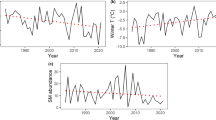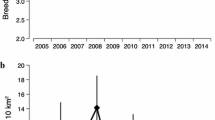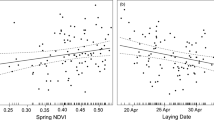Abstract
Contemporary research has documented a large number of shifts in spring phenology and changes in distribution range although the average spring temperatures have increased by only 0.3–0.6 °C over the past 100 years. Generally, earlier breeding birds have larger clutch sizes, and the advancing spring could thus potentially increase breeding success. Shifts in spring phenology can, however, be crucial for bird reproduction, and mistiming the breeding event may even have negative consequences for population development. Our aim was to explore how weather and prey abundance relates to the breeding performance of a north European top predator, the northern goshawk Accipiter gentilis. Our nationwide dataset from Finland, spanning the period 1989–2004, shows that ambient weather has a greater impact on the timing and success of breeding than the density of grouse Tetraonidae, the main prey of goshawks. Higher early spring temperatures were associated with advancing hatching date of goshawks. Correspondingly, grouse density and temperature during laying and brooding were positively associated with brood size, while precipitation showed a negative connection. Applying our models to a future scenario of climate warming, combined with a 50 % reduction in grouse density, suggests that average breeding dates will advance only 2.5 days and average breeding success would remain the same. Notably, breeding success was not spatially equal throughout Finland, as northern and eastern populations suffered most from declining grouse densities. The observed pattern is thus the opposite to what is expected from a population situated at the northern edge of its distribution range, and thus may help to understand why populations may not increase at the northern edge of their thermal distribution due to climate change.




Similar content being viewed by others
References
Birkhead M, Bacon P, Walter P (1983) Factors affecting the breeding success of the mute swan Cygnus olor. J Anim Ecol 52:727–741. doi:10.2307/4450
Böhning-Gaese K, Lemoine N (2004) Importance of climate change for ranges. Communities and conservation of birds. Adv Ecol Res 35:211–236
Bolker BM, Brooks ME, Clark CJ, Geange SW, Poulsen JR, Stevens MH, White J-SS (2009) Generalized linear mixed models: practical guide for ecology and evolution. Trends Ecol Evol 24:127–135. doi:10.1016/j.tree.2008.10.008
Both C, Bouwhuis S, Lessells CM, Visser ME (2006) Climate change and population declines in a long-distance migratory bird. Nature 441:81–83. doi:10.1038/nature04539
Both C, van Asch M, Bijlsma RG, van den Burg AB, Visser ME (2009) Climate change and unequal phenological changes across four trophic levels: constraints or adaptations? J Anim Ecol 78:73–83
Burnham K, Anderson D (2002) Model selection and multimodel inference: a practical information-theoretic approach, 2nd edn. Springer, New York
Byholm P (2003) Reproduction and dispersal of goshawk in a variable environment. PhD thesis, University of Helsinki
Byholm P (2005) Site-specific variation in partial brood loss in northern goshawks. Ann Zool Fenn 42:81–90
Byholm P, Kekkonen M (2008) Food regulates reproduction differently in different habitats: experimental evidence in the goshawk. Ecology 89:1696–1702. doi:10.1890/07-0675.1
Byholm P, Nikula A (2007) Nesting failure in Finnish Northern Goshawks Accipiter gentilis: incidence and cause. Ibis 149:597–604. doi:10.1111/j.1474-919X.2007.00687.x
Byholm P, Nikula A, Kenttä J, Taivalmäki J-P (2007) Interactions between habitat heterogeneity and food affect reproductive output in a top predator. J Anim Ecol 76:392–401. doi:10.1111/j.1365-2656.2007.01211.x
Byholm P, Rousi H, Sole I (2011) Parental care in nesting hawks: breeding experience and food availability influence the outcome. Behav Ecol 22:609–615. doi:10.1093/behaco/arr019
Cramp S, Simmons KEL (1980) The birds of Western Palearctic, vol II. Hawks to bustards. Oxford University Press, New York
Daan S, Tinbergen JM (1997) Adaptation of life history. In: Krebs JR, Davies NB (eds) Behavioural ecology, 4th edn. Blackwell, Oxford, pp 311–333
Dunn P (2004) Breeding date and reproductive performance. Adv Ecol Res 35:69–87
Gaston AJ, Gilchrist HG, Hipfner JM (2005) Climate change, ice conditions and reproduction in an Arctic nesting marine bird: Brunnich’s guillemot (Uria lomvia L.). J Anim Ecol 74:832–841. doi:10.1111/j.1365-2656.2005.00982.x
Huntley B, Green ER, Collingham YC, Willis SG (2008) A climatic atlas of European breeding birds. Lynx, Madrid
Intergovernmental Panel on Climate Change, IPCC (2007) Climate change 2007: synthesis report. Fourth Assessment Report. http://www.ipcc.ch/
Jiguet F, Devictor V, Ottvall R, van Turnhout C, van der Jeugd H, Lindström A (2010) Bird population trends are linearly affected by climate change along species thermal ranges. Proc R Soc B 277:3601–3608. doi:10.1098/rspb.2010.0796
Johnson JB, Omland KS (2004) Model selection in ecology and evolution. Trends Ecol Evol 19:101–108. doi:10.1016/j.tree.2003.10.013
Jylhä K, Tuomenvirta H, Ruosteenoja K (2004) Climate change projections for Finland during the 21st century. Boreal Environ Res 9:127–152
Jylhä K, Ruosteenoja K, Räsänen J, Venäläinen A, Tuomenvirta H, Ruokolainen L, Saku S, Seitola T (2009) The changing climate in Finland: estimates for adaptation studies. ACCLIM project report 2009. Finnish Meteorological Institute (in Finnish with English summary)
Klomp H (1970) The determination of clutch-size in birds. A review. Ardea 58:2–123
Korpimäki E, Hakkarainen H (1991) Fluctuating food supply affects the clutch size of Tengmalm’s owl independent of laying date. Oecologia 85:543–552
Kostrzewa A, Kostrzewa R (1990) The relationship of spring and summer weather with density and breeding performance of the buzzard Buteo buteo, goshawks Accipiter gentilis and kestrel Falco tinnunculus. Ibis 132:550–559
Krüger O (2004) The importance of competition, food, habitat, weather and phenotype for the reproduction of buzzard Buteo buteo. Bird Study 51:125–132
Kullman L (2002) Rapid recent range-margin rise of tree and shrub species in the Swedish Scandes. J Ecol 90:68–77. doi:10.1046/j.0022-0477.2001.00630.x
Lehikoinen E, Sparks TH, Zalakevicius M (2004) Arrival and departure dates. Adv Ecol Res 35:1–31
Lehikoinen A, Kilpi M, Öst M (2006) Winter climate affects subsequent breeding success of common eiders. Glob Change Biol 12:1355–1365. doi:10.1111/j.1365-2486.2006.01162.x
Lehikoinen A, Byholm P, Ranta E, Saurola P, Valkama J, Korpimäki E, Pietiäinen H, Henttonen H (2009) Reproduction of the common buzzard at its northern range margin under climate change. Oikos 118:829–836. doi:10.1111/j.1600-0706.2008.17440.x
Lehikoinen A, Ranta E, Byholm P, Saurola P, Valkama J, Pietiäinen H, Huitu O, Henttonen H, Korpimäki K (2011) The impact of climate and cyclic food abundance on the timing breeding and brood size in four boreal owl species. Oecologia 165:349–355. doi:10.1007/s00442-010-1730-1
Lindén H (ed) (2002) Metsäkanalintututkimuksia: Metsäkanalintukannat. Riista- ja kalatalouden tutkimuslaitos, Metsästäjäin Keskusjärjestö, Gummerus Kirjapaino OY, Saarijärvi (in Finnish)
Lindén H, Wikman M (1980) Brood size of the goshawk in relation to tetraonid densities (in Finnish with English summary). Suomen Riista 27:63–69
Lindén H, Wikman M (1983) Goshawk predation on tetraonids—available of prey and diet of the predator in the breeding season. J Anim Ecol 52:953–968
Lindén H, Helle E, Helle P, Wikman M (1996) Wildlife triangle scheme in Finland: methods and aims for monitoring wildlife populations. Finn Game Res 49:4–11
Ludwig GX, Alatalo RV, Helle P, Lindén H, Lindström J, Siitari H (2006) Short- and long-term population dynamical consequences of asymmetric climate change in black grouse. Proc R Soc Lond B 273:2009–2016. doi:10.1098/rspb.2006.3538
Mearns R, Newton I (1988) Factors affecting breeding success of Peregrines in southern Scotland. J Anim Ecol 57:903–916
Newton I (1986) The sparrowhawk. Poyser, Calton
Newton I, Dale L (1996) Relationship between migration and latitude among west European birds. J Anim Ecol 65:137–146
Nielsen JT, Drachmann J (2003) Age-dependent reproductive performance in northern goshawk Accipiter gentilis. Ibis 145:1–8
Nielsen JT, Møller AP (2006) Effect of food abundance density and climate change on reproduction in the sparrowhawk Accipiter nisus. Oecologia 149:505–518. doi:10.1007/s00442-006-0451-y
Nilsson L (1979) Variation in the production of young of swans wintering in Sweden. Wildfowl 30:129–134
Parmesan C (2006) Ecological and evolutionary responses to recent climate change. Annu Rev Ecol Evol Syst 37:637–669. doi:10.1146/annurev.ecolsys.37.091305.110100
Pietiäinen H (1989) Seasonal and individual variation in the production of offspring in Ural owl. J Anim Ecol 58:905–920
Przbylo R, Sheldon BC, Merilä J (2000) Climatic effects on breeding and morphology: evidence for phenotypic plasticity. J Anim Ecol 69:395–403
Rainio K, Laaksonen T, Ahola M, Vähätalo AV, Lehikoinen E (2006) Climatic responses in spring migration of boreal and arctic birds in relation to wintering area and taxonomy. J Avian Biol 27:507–515. doi:10.1111/j.0908-8857.2006.03740.x
Reif V (2008) Birds of prey and grouse in Finland—do avian predators limit or regulate their prey numbers. PhD thesis, Oulu University
Rodríguez CR, Bustamante J (2003) The effect of weather on lesser kestrel breeding success: can climate change explain historical population declines? J Anim Ecol 72:793–810. doi:10.1046/j.1365-2656.2003.00757.x
Saurola P (2008) Monitoring birds of prey in Finland: a summary of methods, trends, and statistical power. Ambio 37:413–419. doi:10.1579/0044-7447(2008)37[416:MBOPIF]2.0.CO;2
Solonen T (1985) Suomen linnusto. Lintutieto, Helsinki (in Finnish)
Solonen T (2008) Larger broods in the northern goshawk Accipiter gentilis near urban areas in southern Finland. Ornis Fenn 85:118–125
Sulkava S (1964) Zur Nahrungsbiologie des Habichts, Accipiter g. gentilis (L.). Aquilo Ser Zool 3:1–103
Sulkava S, Huhtala K, Tornberg R (1994) Regulation of goshawk Accipiter gentilis breeding in Western Finland over the last 30 years. In: Meyburg B-U, Chancellor RD (eds) Raptor conservation today. Pica Press, Berlin, pp 67–76
Sulkava S, Lokki H, Linkola P (2006) The diet of the goshawk Accipiter gentilis during nesting season in Häme (Southern Finland). Suomen Riista 52:85–96
Tornberg R (1997) Prey selection of the goshawk Accipiter gentilis during the breeding season: the role of prey profitability and vulnerability. Ornis Fenn 74:15–28
Tornberg R (2000) Effect of changing landscape structure on the predator-prey interaction between goshawk and grouse. PhD thesis, Oulu University
Tornberg R, Colpaert A (2001) Survival, ranging, habitat choice and diet of the northern goshawk Accipiter gentilis during winter in Northern Finland. Ibis 143:41–50. doi:10.1111/j.1474-919X.2001.tb04168.x
Tornberg R, Reif V (2007) Assessing the diet of birds of prey: a comparison of prey items found in nests and images. Ornis Fenn 84:21–31
Tornberg R, Korpimäki E, Jungell S, Reif V (2005) Delayed numerical response of goshawk to population fluctuation of forest grouse. Oikos 111:408–415. doi:10.1111/j.0030-1299.2005.14066.x
Vähätalo AV, Rainio K, Lehikoinen A, Lehikoinen E (2004) Spring arrival of birds depends on the North Atlantic oscillation. J Avian Biol 35:210–216. doi:10.1111/j.0908-8857.2004.03199.x
Väisänen RA (2006) Monitoring population changes of 86 land bird species breeding in Finland in 1983–2005 (in Finnish with English summary). Linnut-vuosikirja 2005:83–98
Väisänen RA, Lammi E, Koskimies P (1998) Distribution, numbers and population changes of Finnish breeding birds. Otava, Keuruu (in Finnish with English summary)
Valkama J, Vepsäläinen V, Lehikoinen A (2011) The Third Finnish Breeding Bird Atlas. Finnish Museum of Natural History and Ministry of Environment. http://atlas3.lintuatlas.fi/english (cited 15 Aug 2011). ISBN 978-952-10-7145-4
Venäläinen A, Tuomenvirta H, Drebs S (2005) A basic Finnish climate data set 1961–2000—description and illustrations. Finnish Meteorological Institute, Meteorological Publications
Virkkala R, Heikkinen RK, Leikola N, Luoto M (2008) Projected large-scale range reductions of northern boreal land bird species due to climate change. Biol Conserv 141:1343–1353. doi:10.1016/j.biocon.2008.03.007
Visser ME, van Noordwijk AJ, Tinbergen JM, Lessells CM (1998) Warmer springs lead to mistimed reproduction in great tits (Parus major). Proc R Soc Lond B 265:1867–1870. doi:10.1098/rspb.1998.0514
Visser ME, Both C, Lambrechts MM (2004) Global climate change leads to mistimed avian reproduction. Adv Ecol Res 35:89–110
Acknowledgments
Many voluntary ringers and hunters have taken part in collecting the goshawks and grouse data. The Ringing Centre of Finnish Museum of Natural History and the Game and Fisheries Research Institute have maintained the electronic ringing and grouse databases. This work was supported by grants from Jenny and Antti Wihuri Foundation (to A. Lehikoinen) and the Academy of Finland (A. Lindén; grant ref. 135682). Comments by Katrin Böhning-Gaese, Robert Kenward and Marcus Wikman improved the clarity of this manuscript. Kim Jaatinen kindly checked the language.
Author information
Authors and Affiliations
Corresponding author
Additional information
Communicated by Christopher Johnson.
E. Ranta: Deceased.
Rights and permissions
About this article
Cite this article
Lehikoinen, A., Lindén, A., Byholm, P. et al. Impact of climate change and prey abundance on nesting success of a top predator, the goshawk. Oecologia 171, 283–293 (2013). https://doi.org/10.1007/s00442-012-2411-z
Received:
Accepted:
Published:
Issue Date:
DOI: https://doi.org/10.1007/s00442-012-2411-z




